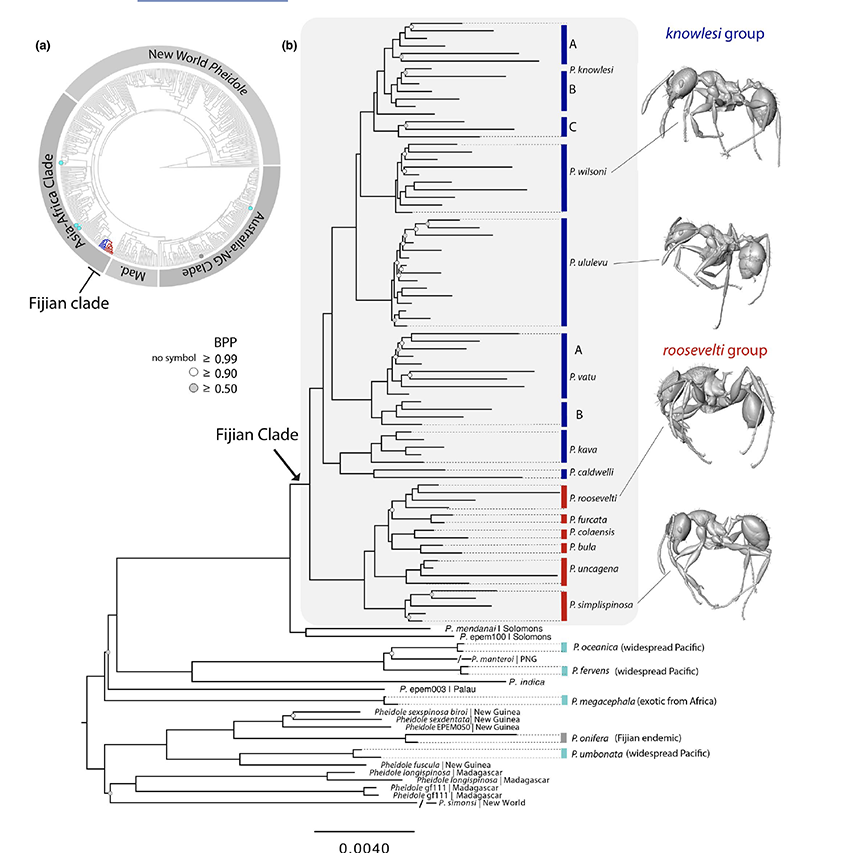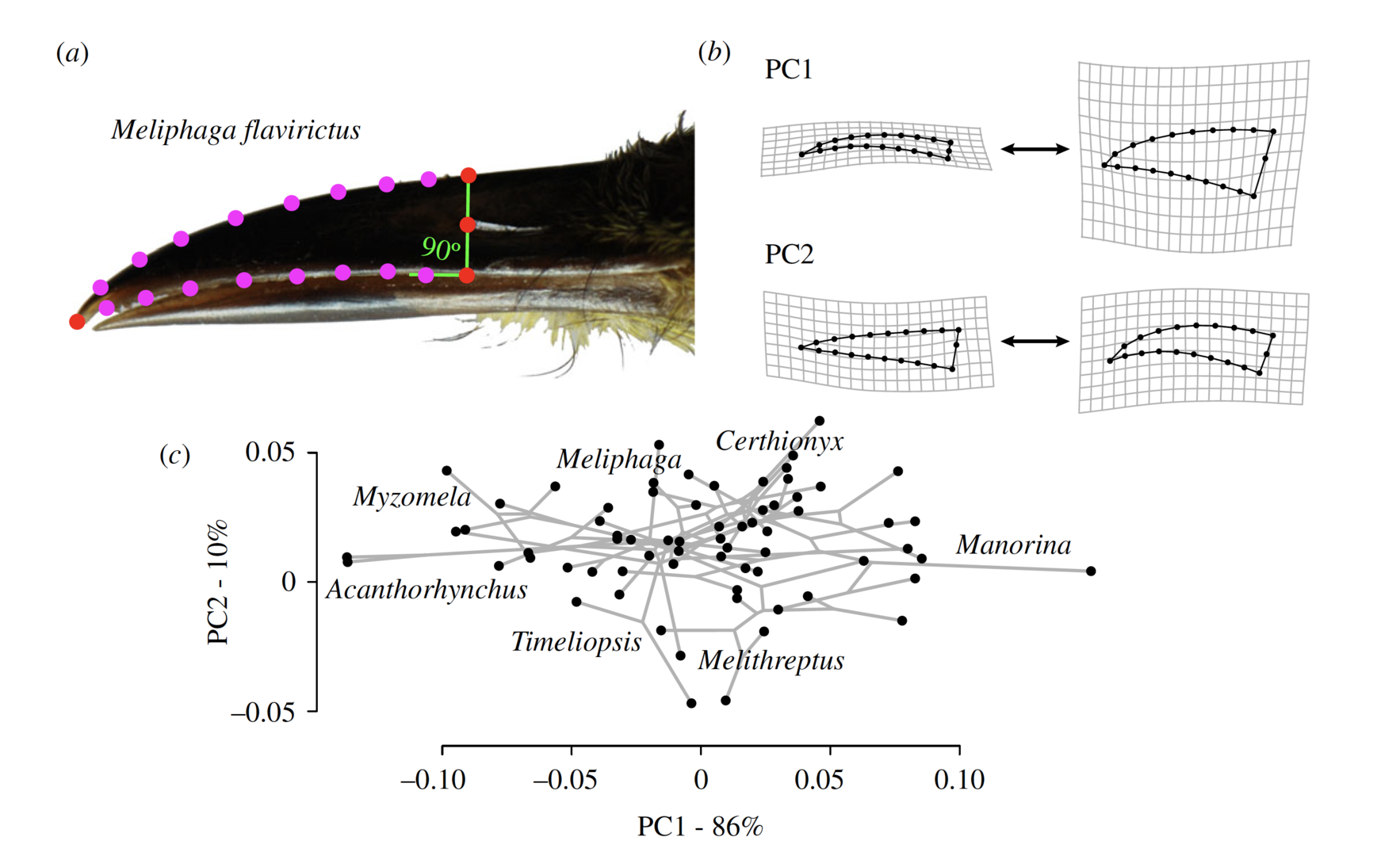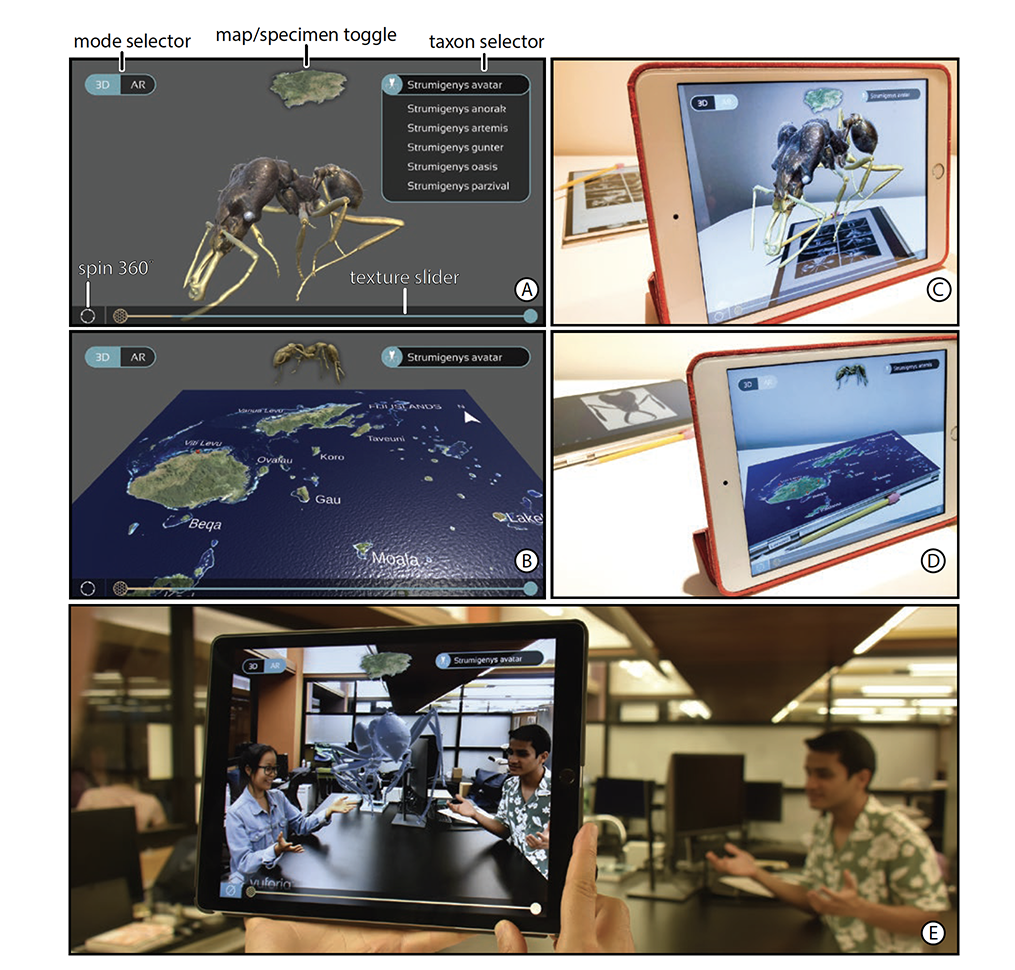FY2019 Annual Report
Biodiversity and Biocomplexity Unit
Assistant Professor Evan Economo

Abstract
Our lab seeks to understand how ecological and evolutionary processes interact to generate and regulate biodiversity across spatiotemporal scales and levels of biological organization. Living systems are diverse from gene sequences to organismal morphology to communities and ecosystems. Our goal as biologists is not just to document and catalogue this diversity, but understand the complex interactions and dynamics that generate and sustain biological variation. In FY2019, our research concentrated in five areas; our project on the evolution of the hyperdiverse ant radiations, our Global Ant Biodiversity Informatics (GABI) project which focuses on compiling analyzing global distributions of past and present ant biodiversity, and systematics, ecology, and evolution of Indo-Pacific ant faunas, the OKEON Churamori Project, and analyzing the evolution of organismal design using x-ray imaging.
1. Staff
• Dr. Francisco Hita Garcia, Staff Scientist
• Dr. Nicholas Friedman, Postdoctoral scholar
• Dr. Georg Fischer, Postdoctoral Scholar
• Dr. Susan Kennedy, Postdoctoral Scholar
• Dr. Nao Takashina, JSPS Postdoctoral Fellow
• Dr. Jamie Kass, JSPS Postdoctoral Fellow
• Fumika Azuma, Research Unit Technician
• Kenneth Dudley, Research Unit Technician
• Dr. Kosmas Deligkaris, Research Unit Technician
• Chisa Oshiro, Research Unit Administrator
• Yuka Suzuki, Graduate Student
• Yazmin Zurita-Gutierrez, Graduate Student
• Julian Katzke, Graduate Student
• Evropi Toulkeridou, Graduate Student
• Aibekova Lazzat, Graduate Student
• Gaurav Agavekar, Graduate Student
• Shubham Gautam, Graduate Student
2. Activities and Findings
2.1 Global Ant Biodiversity Informatics (GABI) Project
Our understanding of large-scale biodiversity patterns has recently increased dramatically, but available information is strongly biased towards a few groups of vertebrates and plants. Biodiversity patterns in invertebrates, such as insects, are poorly documented despite representing the large majority of species. To address this gap in our knowledge, the Global Ant Biodiversity Informatics (GABI) project has compiled over 250 years of ant research into a single database providing distribution information for all ant species. These data can be used to support all kinds of research and are being used somehow in most of our ant projects. However, the two main analyses we are working on with these data are analyzing global ant diversification patterns across the globe, and a comparison of how global patterns of ant endemism compare with vertebrate groups. In FY2019, we have continued to maintain and build the GABI dataset so it can be used for different research purposes. We started a major georeferencing effort to increase the number of geolocated occurence points available, and developed a range-mapping pipeline. We plan to complete a broad analysis of high resolution global diversity patterns in FY2020.
2.2 Evolution, Ecology, and Systematics of Hyperdiverse Ant Radiations
Over evolutionary time lineages evolve in and out of ecological niches, evolve through morphological spaces, and ranges expand and contract in geographic space. These transitions may not be independent, some phenotypes may be better suited to certain ecological habitats, some habitats may promote dispersal and colonization, and colonization of new geographic areas may lead to ecological niche shifts. These ideas form the basis for integrative hypotheses like the taxon cycle. In collaboration with the Knowles lab at the U. of Michigan, we have a funded project to examine the joint dynamics of these transitions in the famously diverse ant genus Pheidole, which contains over 1000 described species and is the dominant ant genus in many tropical ecosystems worldwide. We reconstructed a new global phylogeny of the genus and used it to analyze its macroevolution and macroecology, with particular attention to the Old World. We also recently initiated new projects on other hyperdiverse ant radiations, namely the genera Strumigenys (in collaboration with Doug Booher) and Tetramorium (led by Staff Scientist Paco Hita Garcia). Strumigenys is a leaf-litter predator that has evolved a complex trap-jaw mechanism, and we are examining the evolution of this trait in time and space. In Tetramorium, we are analyzing biogeography, morphological evolution, and transitions between ecological generalism and specialism. Specimen work and RAD-sequencing for phylogenomics reconstruction is ongoing for these groups.
In FY2019, we made progress on all of the projects above, with phylogenies available for Strumigenys, Tetramorium, and Pheidole. We submitted a new global phylogeny of Strumigenys, which is still going through the review process. We are moving toward final phylogenies of Tetramorium and should complete this analysis next year. In the meantime, we published papers on morphological diversification of Pheidole (Friedman et al. 2019), an analysis of island diversification in Pheidole (Darwell et al. 2020), and a revision of Fijian Strumigenys (Sarnat et al. 2019).
2.3 Biodiversity, Biogeography, and Evolutionary Ecology of Indo-Pacific Biodiversity
Ants are among the most ubiquitous and ecologically dominant animal groups. Over millions of years, ant biodiversity has evolved and dispersed from Asia and Australia through the vast network of Pacific islands. More recently, humans have unintentionally introduced many species from around the globe into the Pacific. We seek to understand the historical and contemporary processes that regulate ant biodiversity over time.
In FY2019, we continued a series of published works on the Indo-Pacific ant faunas, including new papers on Fijian Strumigenys (Sarnat et al. 2019) and Fijian Pheidole (Darwell et al. 2020). We also tested island biogeography theory on the avifauna of the Ryukyu islands (Ross et al. 2019), and analyzed coral symbiont communities (Wepfer et al. 2020). Other work included systematics papers on Arabian (Sharaf et al. 2019) and Afrotropical (Hita Garcia et al. 2019) ants.

Figure 1: We recently published a study integrating population genomics and micro-ct to analyze morphological diversification and demography of Pheidole ants on the Fijian archipelago (Darwell et al. 2020, Molecular Ecology). The combined data were used to test theory of community assembly.
2.4 OKEON Churamori Project
In collaboration with other researchers OIST, in FY2013 we initiated a major initiative called the OKEON Chura-Mori Project (OKEON stands for Okinawa Environmental Observation Network). The goal is to develop an observation system to measure and monitor the environment of Okinawa, in collaboration with the people of Okinawa. The primary scientific goal is to develop long-term space-time data series from sites across the island.
During FY2019, the field network is now fully operational and collecting data every 2 weeks. We have also been broadening the activities and partners, we now have over 140 partners in the project. See the OKEON website for more on our activities. In FY2019 we focused on completing a 2-year dataset of biweekly ant community changes across our sampling network, and are analyzing this dataset now. We continued a Pacific-wide collaboration with colleagues in the US (Rosemary Gillespie, George Roderick, Haldre Rogers) and Germany (Henrik Krehenwinkel) to deploy metabarcoding methods in Okinawa and across the Pacific islands. Field work was conducted in Okinawa, the Marianas, and Hawaii using the same protocol to test for biogeographic differences in disturbance responses. Data will be analyzed in FY2020.
We continued to participate in ant surveillance research in Japan, with the species arriving to many ports across the country. We continued our OPG-funded project to use the OKEON system to monitor for fire ants and other introduced species. We are working with community programs to use social network to identify fire ants, and use trapping methods at sensitive areas to identify the ant after it arrives. A major development on this front was the procurement of a Ministry of Environment research grant for fire ant countermeasures, in collaboration with colleagues in Japan. Our part will be to develop metabarcoding methods for introduced species surveillance.
2.5 Analyzing evolution of organismal design with X-ray micro-CT
Since the earliest biological studies, description and quantification of biological structures has been a basic goal of biology as well as a first step toward deeper understanding of ecological and evolutionary processes. In Entomology, the primary imaging tools have traditionally been optical microscopy and SEM, which are essential for certain tasks and allow us to see complex structures well. But these are limited in our ability to quantitatively characterize complex shapes, surfaces, and textures. X-Ray CT has the potential to complement existing tools by providing a digital 3D image of the interior and exterior of the organism. These images can be manipulated, dissected, measured, and quantified. We have been developing imaging and post-processing techniques to better quantify the functional morphology of ants, including both external and internal structures. This provides a basis for a research program analyzing the evolution of organismal design.
In FY2019, we analyzed the evolution of organism design using a variety of systems and techniques. First, we published a paper on evolutionary among traits in species with polymorphism, such as across different sexes or social insect castes (Friedman et al. 2019). Second, we analyzed evolution of bird beaks in Australia, with reference to different evolutionary functions (Friedman et al. 2020). Third, we analyzed the evolution of Pheidole morphological diversification in Fiji (Darwell et al. 2020). We continued progress on a number of evolutionary morphology studies that will be submitted in the next year.

Figure 2: We recently analyzed the evolution of bird beak size and shape (Friedman et al. 2020, Proc. B.) using Australian songbirds as a model system. We found that thermoregulation and diet had shared effects on bird beak morphology, with carry-on effects on song evolution.
In addition to evolutionary studies, we continued our work on integrating micro-CT and 3D imagery into systematic biology, with enhanced contributions on Discothyrea (Hita Garcia et al. 2019), Arabian Temnothroax (Sharaf et al. 2019), and Strumigenys (Sarnat et al. 2019). In particular, in the latter contribution we explored the use of augmented reality to enhance taxonomic revision. It was the first taxonomic paper to come with its own iphone app, Insects3D (Figure 3).

Figure 3: Screenshots from our Insects3D application. We presented this custom app in a recent publication (Sarnat et al. 2019, Insect Systematics and Diversity) which allows the user to interact with 3D models and maps in augmented reality, a first for systematic studies.
3. Publications
3.1 Journals
- Kennedy, S.R., Tsau, S., Gillespie, R., Krehenwinkel, H. Are you what you eat? A highly transient and prey-influenced gut microbiome in the grey house spider Badumna longinqua. Molecular Ecology, https://doi.org/10.1111/mec.15370 (2020).
- Kennedy, S.R., Prost, S., Overcast, I., Rominger, A.J., Gillespie, R.G., Krehenwinkel, H. High-throughput sequencing for community analysis: the promise of DNA barcoding to uncover diversity, relatedness, abundances and interactions in spider communities. Development Genes and Evolution, https://doi.org/10.1007/s00427-020-00652-x (2020).
- Darwell, C., Fischer, G., Sarnat, E.M., Friedman, N.R., Liu, C., Baiao, G., Mikheyev, A.S. Economo, E.P. Genomic and phenomic analysis of island ant community assembly. Molecular Ecology, https://doi.org/10.1111/mec.15326 (2020).
- de Kerdrel G. A., Andersen J., Kennedy S. R., Gillespie R., Krehenwinkel H. Rapid and cost-effective generation of single specimen multilocus barcoding data from whole arthropod communities by multiple levels of multiplexing. Scientific Reports, https://doi.org/10.1038/s41598-019-54927-z (2020).
- Wepfer, P., Nakajima, Y., Hui, F.K.C., Mitarai, S.*, Economo, E.P.* Metacommunity ecology of Symbiodiniaceae hosted by the coral Galaxea fascicularis. Marine Ecology Progress Series, https://doi.org/10.3354/meps13177 (2020). *joint supervision
- Choo, J., Gill, B., Zuur, A., Zent, E., Economo, E.P. Impacts of an indigenous settlement on taxonomic and functional dung beetle diversity in the Venezuelan Amazon. Biodiversity and Conservation, https://doi.org/10.1007/s10531-019-01879-5 (2019).
- Kennedy S., Lim J. Y., Clavel J., Krehenwinkel H., and R. G. Gillespie. Spider webs, stable isotopes and molecular gut content analysis: Multiple lines of evidence support trophic niche differentiation in a community of Hawaiian spiders. Functional Ecology, https://doi.org/10.1111/1365-2435.13361 (2019).
- Friedman, N., Miller, E., Ball, J., Kasuga, H., Remeš, V.*, Economo, E.P.* Evolution of a multifunctional trait: shared effects of foraging ecology and thermoregulation on beak morphology, with consequences for song evolution. Proceedings of the Royal Society: Series B, http://dx.doi.org/10.1098/rspb.2019.2474 (2019). *joint supervision
- Hita Garcia, F., Lieberman, Z., Audisio, T., Liu, C., Economo, E.P. Revision and microtomography of the cryptic and highly specialized ant genus Discothyrea (Hymenoptera: Formicidae) in the Afrotropical region. Insect Systematics and Diversity, https://doi.org/10.1093/isd/ixz015 (2019).
- Sarnat, E.M., Hita Garcia, F., Dudley, K., Liu, C., Fischer, G., Economo, E.P. Ready Species One: exploring the use of augmented reality to enhance systematic biology with a revision of Fijian Strumigenys (Hymenoptera: Formicidae). Insect Systematics and Diversity, https://doi.org/10.1093/isd/ixz005 (2019).
- Sharaf, M.R., Aldawood, A.S., Economo, E.P., Wachkoo, A.A., Hita Garcia, F. Taxonomy of Arabian Temnothorax Mayr (Formicidae: Myrmicinae) with description of a new species enhanced by micro-CT next-generation morphology. Scientific Reports, https://doi.org/10.1038/s41598-019-47260-y (2019).
- Friedman, N.R., Remeš, V., Economo, E.P. A morphological integration perspective on the evolution of dimorphism in sexes and social insect castes. Integrative and Comparative Biology, https://doi.org/10.1093/icb/icz053 (2019).
- Ross, S.R.P.-J., Friedman, N., Janicki, J., Economo, E.P. A test of trophic and functional island biogeography theory with the avifauna of a continental archipelago. Journal of Animal Ecology, https://doi.org/10.1111/1365-2656.13029 (2019).
- Cibois, A., Thibaut, J., Friedman, N.R., Omland, K.E., Desutter-Grandcolas, L., Robillard, T., Pasquet, E. Reed warblers in the Marquesas Islands: song divergence and plumage convergence of two distinct lineages. Emu – Austral Ornithology, https://doi.org/10.1080/01584197.2019.1597633 (2019).
- Andersen, M.J., McCullough, J.M., Friedman, N.R., Peterson, A.T., Moyle, R.G., Joseph, L., Nyári, A.S. Ultraconserved elements resolve genus-level relationships in a major Australasian bird radiation (Aves: Meliphagidae). Emu – Austral Ornithology, https://doi.org/10.1080/01584197.2019.1595662 (2019).
- Souto‐Vilarós, D., Proffit, M., Buatois, M., Rindos, M., Sisol, M., Kuyaiva, T., Isua, B., Michalek, J., Darwell, C., Hossaert-Mckey, M., Weiblen, G.D., Novotny, V., Segar, S. Pollination along an elevational gradient mediated both by floral scent and pollinator compatibility in the fig and fig‐wasp mutualism. Journal of Ecology, https://doi.org/10.1111/1365-2745.12995 (2018).
3.2 Oral and Poster Presentations
- Kennedy, Susan R. Trophic niche differentiation within the adaptive radiation of Hawaiian Tetragnatha spiders, Trier, Rhineland-Palatinate, Germany, February 3 (2020).
- Kass, J., Using biotic interactions and diversity to predict species' ranges and examine community change, National Institute of Environmental Studies, Tsukuba, Ibaraki, Japan, November 29 (2019).
- Kass, J., Species Distribution Modeling for Conservation, Training workshop: Species Distribution Modeling for Conservation, Thanh Xuan District, Hanoi, Vietnam, November 25 - 26 (2019).
- Kennedy, Susan R. Individuals as communities: Gut content metabarcoding reveals complex ecological relationships in spiders, Nicosia, Nicosia District, Cyprus, November 15 (2019).
- Hita Garcia, F. Morphology reloaded (again) - ANTSCAN or how to connect phenotypes with genotypes through next-generation phenomics, XXIV Simposio de mirmecologia – an international ant meeting, Federal University of Minas Gerais, Belo Horizonte, MINAS GERAIS, Brazil, October 4 (2019).
- Katzke, Jl, Hita Garcia, F., Richter, A., Ferreira, Alexandre C., Economo, E. A morphospace odyssey: Quantifying mandible diversity across the ant phylogeny, XXIV Simposio de Mirmecologia, Belo Horizonte, State of Minas Gerais, Brazil, October 3 (2019).
- Hita Garcia, F. Ghost in the shell: Next-generation phenomics and 3D cybertaxonomy in ants, XXIV Simposio de mirmecologia – an international ant meeting, Federal University of Minas Gerais, Belo Horizonte, MINAS GERAIS, Brazil, October 3 (2019).
- Hita Garcia, F. Morphology in the 21st century - next generation phenomics, virtual avatars, and 3D cybertaxonomy, Federal University of Parana Curitiba, Curitiba, Paraná, Brazil, September 25 (2019).
- Economo, Evan P., Friedman, N., Hita Garcia, F., Fischer, G., Blaimer, B., Booher, D., Katzke, J., Khalife, A., Toulkeridou, E., Aibekova, L., Mikheyev, A., Fisher, B. Unraveling the stages of ant diversification in Madagascar, III International Conference Society for Island Biology, The University of La Réunion, Réunion, July 9 (2019).
- Kennedy, S., Krehenwinkel, H., Rueda, A., Barner, A., Gillespie, R. Niches in time: Molecular gut content analysis reveals changing ecological relationships among Hawaiian Tetragnatha spiders along a chronosequence, III International Conference Society for Island Biology, The University of La Réunion, Réunion, July 8 (2019).
- Economo, E. Linking evolutionary Innovation and the diversification of organismal design using ants as a model system, Sorbonne University, Paris, France, May 5 (2019).
- Economo, E. Linking evolutionary Innovation and the diversification of organismal design using ants as a model system, University of Lausanne, Lausanne, Switzerland, May 3 (2019).
4. Meetings and Events
4.1 Talks by visitors
- Prof. Aliza le Roux, University of the Free State, "Risk and co-existence: How small mammals respond to environmental and anthropogenic change” (December 4, 2019)
- Prof. Christian Peeters, iEES, Sorbonne Université, “Engineering a novel lifestyle: Melissotarsus and Rhopalomastix ants chew tunnels in healthy wood to accommodate their scale insect partners” (December 2, 2019)
- Prof. Nessa E. O'Connor, Trinity College Dublin, “Blue solutions to global challenges: experimental tests of environmental change on species interactions” (July 16, 2019)
- Dr. Thomas van de Kamp, Karlsruhe Institute of Technology (KIT), “High-throughput synchrotron X-ray imaging of extant and fossil insects” (May 27, 2019)
- Prof. Rolf G. Beutel, FSU Jena, "Insect morphology in the age of phylogenomics" (March 13, 2019)
- Prof. Henrik Krehenwinkel, Universität Trier, "A high throughout metabarcoding analysis to infer biodiversity dynamics of arthropods across the Hawaiian Island chronosequence" (February 22, 2019)
4.2 Events
- Ant Biodiversity Data Synthesis: Present and Future (OIST Mini Symposium), January 21 - 23, 2020
- The 3rd International Symposium on Swarm Behavior and Bio-Inspired Robotics (SWARM2019), November 20 - 22, 2019



